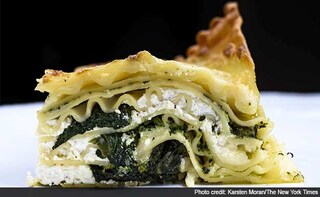Lasagna, that many-layered marvel, is a dish that shifts with the seasons. Like fashion, it comes in different hues and textures that match the weather.
Time: 1 1/2 hours
Yield: 6 servings
For the béchamel sauce:
4 tablespoons butter
1/4 cup all-purpose flour
2 cups half-and-half, heated, plus a little more if necessary
Salt and pepper
Pinch of cayenne
Grated nutmeg, to taste For the lasagna:
1 pound dry lasagna noodles
Salt and pepper
2 bunches broccoli raab, about 2 pounds
4 garlic cloves, minced
1/2 cup extra-virgin olive oil
1 pound ricotta cheese
1/2 teaspoon grated lemon zest
4 tablespoons butter
4 ounces grated Parmesan, about 2 cups, or a combination of Parmesan and pecorino 1. Make the béchamel: Melt butter in a small saucepan. Whisk in flour and cook for a minute over medium heat without browning. Gradually whisk in half-and-half, 1/2 cup at a time, to obtain a smooth, lightly thickened sauce. Turn heat to low. Add 1/2 teaspoon salt, some ground black pepper, the cayenne and nutmeg. Cook, whisking, for 4 to 5 minutes, then place saucepan in a hot-water bath to keep sauce warm. Thin if necessary with a little more half-and-half. 2. Bring a large pot of well-salted water to the boil. Add lasagna noodles and cook for 5 minutes. Lift noodles from water with a spider and rinse well in a bowl of cold water. Drain and lay noodles flat on a kitchen towel. 3. Using the same cooking water, blanch the greens for 1 minute, until just wilted. Rinse greens with cool water, squeeze dry and chop them roughly. Put 1 cup of chopped greens, the minced garlic and 1/2 cup olive oil in a food processor or blender and purée to make a pesto. Season with salt and pepper to taste and transfer to a small bowl. 4. Mix the ricotta and lemon zest in a small bowl and season with salt and pepper to taste. Heat oven to 375 degrees. Organize to have all ingredients within easy reach for assembling lasagna. Use 2 tablespoons butter to grease an 8-by-10-inch baking dish. 5. Assemble the lasagna: Put a layer of cooked noodles on the bottom of the baking dish. Spoon a quarter of the béchamel over noodles, then dot with a third of the ricotta. Complete layer with chopped greens, a drizzle of pesto and some grated cheese. Continue layering, finishing with a layer of pasta. Spread the last of the béchamel on top and sprinkle with Parmesan. (There should be 4 layers of pasta and 3 layers of filling.) 6. Dot with remaining butter and bake, covered with foil, for 20 minutes. Uncover and bake for 20 minutes more, until nicely browned and bubbling. Let lasagna rest 10 minutes before serving. And To Drink ... The filling of a lasagna dictates the wine you choose for it. In this case, pleasantly bitter broccoli raab calls for a dry, slightly herbal white. You could start with myriad choices from Italy: falanghinas and fianos from Campania, good Orvietos from Umbria, Gavi from the Piedmont, Ligurian vermentinos and many others. You could easily stray as well: dry, restrained sauvignon blancs in the Loire style would be just right, as would good village or premier cru Chablis. The better dry Provençal rosés would be lovely, as would blanc de blancs Champagne and other sparkling wines, as long as they’re not too fruity. I’d steer clear of reds, but if you must, try a light, dry style like a Bardolino, traditional Valpolicella or even a gamay from the Valle d’Aosta. - ERIC ASIMOV © 2015 New York Times News Service
Advertisement
Advertisement
Time: 1 1/2 hours
Yield: 6 servings
For the béchamel sauce:
4 tablespoons butter
1/4 cup all-purpose flour
2 cups half-and-half, heated, plus a little more if necessary
Salt and pepper
Pinch of cayenne
Grated nutmeg, to taste For the lasagna:
1 pound dry lasagna noodles
Salt and pepper
2 bunches broccoli raab, about 2 pounds
4 garlic cloves, minced
1/2 cup extra-virgin olive oil
1 pound ricotta cheese
1/2 teaspoon grated lemon zest
4 tablespoons butter
4 ounces grated Parmesan, about 2 cups, or a combination of Parmesan and pecorino 1. Make the béchamel: Melt butter in a small saucepan. Whisk in flour and cook for a minute over medium heat without browning. Gradually whisk in half-and-half, 1/2 cup at a time, to obtain a smooth, lightly thickened sauce. Turn heat to low. Add 1/2 teaspoon salt, some ground black pepper, the cayenne and nutmeg. Cook, whisking, for 4 to 5 minutes, then place saucepan in a hot-water bath to keep sauce warm. Thin if necessary with a little more half-and-half. 2. Bring a large pot of well-salted water to the boil. Add lasagna noodles and cook for 5 minutes. Lift noodles from water with a spider and rinse well in a bowl of cold water. Drain and lay noodles flat on a kitchen towel.
Advertisement
Advertisement
For the latest food news, health tips and recipes, like us on Facebook or follow us on Twitter and YouTube.
Advertisement
Tags:
